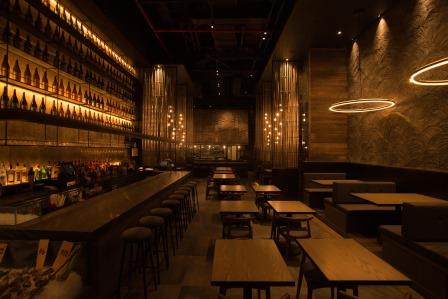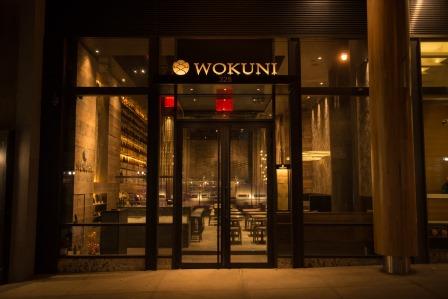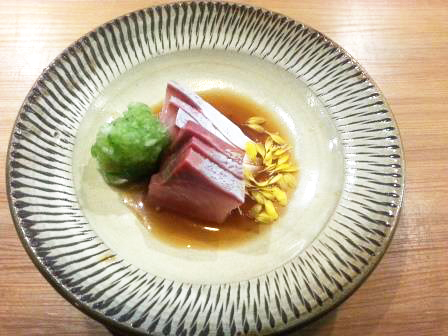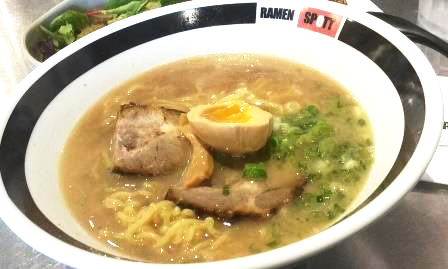WOKUNI Spreading Japan’s high-quality fresh seafood to the world
By Aya Ota
“WOKUNI”, an innovative restaurant which offers fresh seafood cultivated directly from their own self-operated aqua-farm in Nagasaki, appeared in Midtown in late October, and has become the talk of the town.
“I would like to spread the Japanese food culture in which people eat fresh seafood, to the world,” says Daiichi Sakamoto, President of Tokyo Ichiban Foods (the company is listed with the first section of the Tokyo Stock Exchange). This company opened a fugu (blowfish) specialty restaurant called “Torafugu Tei” first in 1996 in Shinjuku, Tokyo, and since then, they have developed a restaurant chain of 50 restaurants specialized in seafood in the Kanto area including “Torafugu Tei” and “Uohkuni”, etc.
With the company’s philosophy, “to serve high quality food ingredients at reasonable prices”, they launched their own aqua-farm in 2011. They are Japan’s one and only food service company which handles everything by themselves including producing, processing, and selling of seafood.
The sales points of “WOKUNI”, their first overseas development, are undoubtedly their own brand tuna and adult yellowtail. Their own aquafarm is located in a cove flourishing with nature, where the clear stream of Yasumandake, the highest peak of Hirado City, Nagasaki prefecture, and Tsushima Ocean current meet. They conduct an environment-friendly sustainable cultivation by not catching young fish until they grow to become as large as 50 kilograms or more, etc. They also follow through with quality control by feeding fish with human-consumable fresh sardine and mackerel. I was impressed to know that they produce tuna and yellowtail, considering American customers who do not care for the fishy smell by making adjustments with the foods for the fish. They are the most particular about freshness. Normally, it would take 5 days for the fish to arrive at the restaurant if distributed through the fish market, but for them, it takes only 48 hours because they use their own distribution route to directly send fish from the aqua-farm. The fish are never frozen in the direct shipping, so the quality and taste stay its best. Cultivating fish in its own fishing ground makes consistent supplying possible, and also their own distributing system allows them to keep the prices as low as 60 to 70% of the normal distributing system. In addition to their own tuna and yellowtail, other naturally-caught fish is procured through their own distribution system every week from Tsukiji and various Kyushu areas, and overall, 80 to 90% of their fish is from Japan. The rich variety on the menu that includes not only sushi and sashimi, but also hot grilled, fried, and BBQed dishes, and cold dishes such as tartar, carpaccio, etc., allows you to enjoy the goodness of seafood fully. 30 brands of Japanese sake are strictly selected with the view of “best pairing with the seafood” in mind. From the end of November, they started to serve lunch, and the items such as seafood bowls, chirashi sushi, unagi bowls, etc., are served with reasonable pricing.
“There is no other country but Japan in which such high-quality seafood can be caught naturally or cultivated. I would like to spread the splendidness of Japanese seafood culture from New York, which can be called the Capital of the world,“ says Mr. Sakamoto as his reason to have chosen New York as the base for the company’s first overseas development. While popularity of sushi and sashimi grows bigger, fish consuming population seems to grow every year by one hundred million globally. “I am surprised that customers’ fish consumption is much larger than I originally expected. I feel that we must set our future prospects by looking at the world from now on,” continued Mr. Sakamoto. At “WOKUNI”, most of their customers are local Americans. After the grand opening,they have been making adjustments in the details of the menu structure, food volume, presentation, tastes, etc. according to the customers’ reactions. Their American customers are speaking highly about the restaurant, saying “It is a place where you can eat high-quality sushi and sashimi at reasonable prices”.
In the future, he wants to expand not only the restaurant business, but the company’s own brand of tuna and yellowtail wholesale business, basing WOKUNI. They keep challenging the world as a general fisheries company. He is very enthusiastic about becoming the base of spreading Japanese food culture itself, not to mention seafood.
日本の高品質な鮮魚を世界に向けて発信
長崎の自社漁場から直送する鮮魚を提供する画期的な店『WOKUNI』(うおくに)が、2017年10月末、ミッドタウンに登場して話題になっている。
「新鮮な魚を食する日本の食文化を世界に広めたい」と語るのは『東京一番フーズ』(東証一部上場企業)の代表取締役社長、坂本大地氏。同社は、1996年に、ふぐ料理専門店『とらふぐ亭』を東京・新宿に開店して以来、現在では、関東地方中心に『とらふぐ亭』や『魚王KUNI』など、魚介料理を強みにしたレストラン約50 店舗を展開している。同社では「こだわりの食材を手頃な価格で提供したい」という理念を持ち、2011年に自社漁場に着手。魚類の生産、加工、販売まで一貫して手がける日本唯一の外食産業だ。
同社の海外初進出店となる『WOKUNI』の目玉は、なんと言っても、自社ブランドのマグロとブリだ。自社漁場は、長崎県平戸市最高峰の安満岳の清流と対馬海流が流れ込む、自然の恵み豊かな入り江に位置している。稚魚の乱獲をせずに50 キロ以上になるまで大きく育てるなど、環境にも配慮したサステナブルな養殖方法を採用。そして、人も食べられる鮮度のイワシやサバを餌として与え、品質管理を徹底している。魚臭を苦手に感じる米国人顧客を意識して、餌を工夫して、魚臭が少ないマグロやブリを生産していることにも驚かされる。一番のこだわりは鮮度だ。通常、市場を介して流通した場合、約5 日かかるところ、自社ルートで漁場からレストランへ直送するため、たった48 時間で到着するという。一切冷凍せずに直送するため、品Interior Exterior質や味の点でも引けを取らない。自社漁場で生産するので安定供給も可能で、市場を介さず自社流通するため価格も約60 〜70%に抑えられる。このマグロとブリ以外にも、独自の流通ルートを通して、築地市場や九州各地から天然魚を毎週取り寄せており、店全体で使う魚介類の8 〜9 割が日本産だ。メニューは、寿司や刺身はもちろんのこと、焼き物、揚げ物、串焼きなどの温菜から、タルタルやカルパッチョなどの冷菜まで豊富に揃い、魚介類の魅力を味わい尽くすことができる。日本酒は“ 魚と合わせて美味しい”という観点で厳選し約30種類用意している。11 月末からはランチもスタート、海鮮丼やちらし寿司、ウナギ丼などを手頃な価格で提供している。
「天然も養殖も、これだけ高品質な魚介類が捕れる国は、日本以外にない。世界の食の首都とも言えるニューヨーク、世界中から多くの人が集まるニューヨークから、日本の魚介類のすばらしさを発信していきたい」と、坂本氏は海外初の拠点をニューヨークに定めた理由を語る。寿司や刺身の人気が高まる中、世界的に見て、魚食人口は毎年1 億人ずつ増えていると言われている。「お客様が魚を食べる量が、当初予想していたよりもはるかに多くて驚いている。これからは世界を見据えていかないといけない」と坂本氏。同店では、顧客のほとんどが地元米国人。グランドオープニング後は、顧客の反応を見ながら、メニュー構成や、ボリュームや盛り付け方、味付けなど、細かい点で見直しをかけているという。米国人客からも「高品質な寿司や刺身をリーズナブルに食べることができる」と好評だ。
今後はこの『WOKUNI』を拠点に、レストラン事業だけでなく、自社ブランドのマグロやブリの卸売り事業を広げていきたいと考えている。“ 総合水産企業”として、世界へ挑戦し続けている。魚介類はもちろんのこと、日本食文化そのものの発信拠点にもなりたいと意欲的だ。
WOKUNI
325 Lexington Ave.
New York, NY 10016
(212) 447-1212
http://wokuninyc.com
Dinner Mon.-Fri. 5:00pm-10:30pm
Lunch Mon.Fri.11:30am-2:45pm
Sunday Closed
“WOKUNI”, an innovative restaurant which offers fresh seafood cultivated directly from their own self-operated aqua-farm in Nagasaki, appeared in Midtown in late October, and has become the talk of the town.
“I would like to spread the Japanese food culture in which people eat fresh seafood, to the world,” says Daiichi Sakamoto, President of Tokyo Ichiban Foods (the company is listed with the first section of the Tokyo Stock Exchange). This company opened a fugu (blowfish) specialty restaurant called “Torafugu Tei” first in 1996 in Shinjuku, Tokyo, and since then, they have developed a restaurant chain of 50 restaurants specialized in seafood in the Kanto area including “Torafugu Tei” and “Uohkuni”, etc.
With the company’s philosophy, “to serve high quality food ingredients at reasonable prices”, they launched their own aqua-farm in 2011. They are Japan’s one and only food service company which handles everything by themselves including producing, processing, and selling of seafood.
The sales points of “WOKUNI”, their first overseas development, are undoubtedly their own brand tuna and adult yellowtail. Their own aquafarm is located in a cove flourishing with nature, where the clear stream of Yasumandake, the highest peak of Hirado City, Nagasaki prefecture, and Tsushima Ocean current meet. They conduct an environment-friendly sustainable cultivation by not catching young fish until they grow to become as large as 50 kilograms or more, etc. They also follow through with quality control by feeding fish with human-consumable fresh sardine and mackerel. I was impressed to know that they produce tuna and yellowtail, considering American customers who do not care for the fishy smell by making adjustments with the foods for the fish. They are the most particular about freshness. Normally, it would take 5 days for the fish to arrive at the restaurant if distributed through the fish market, but for them, it takes only 48 hours because they use their own distribution route to directly send fish from the aqua-farm. The fish are never frozen in the direct shipping, so the quality and taste stay its best. Cultivating fish in its own fishing ground makes consistent supplying possible, and also their own distributing system allows them to keep the prices as low as 60 to 70% of the normal distributing system. In addition to their own tuna and yellowtail, other naturally-caught fish is procured through their own distribution system every week from Tsukiji and various Kyushu areas, and overall, 80 to 90% of their fish is from Japan. The rich variety on the menu that includes not only sushi and sashimi, but also hot grilled, fried, and BBQed dishes, and cold dishes such as tartar, carpaccio, etc., allows you to enjoy the goodness of seafood fully. 30 brands of Japanese sake are strictly selected with the view of “best pairing with the seafood” in mind. From the end of November, they started to serve lunch, and the items such as seafood bowls, chirashi sushi, unagi bowls, etc., are served with reasonable pricing.
“There is no other country but Japan in which such high-quality seafood can be caught naturally or cultivated. I would like to spread the splendidness of Japanese seafood culture from New York, which can be called the Capital of the world,“ says Mr. Sakamoto as his reason to have chosen New York as the base for the company’s first overseas development. While popularity of sushi and sashimi grows bigger, fish consuming population seems to grow every year by one hundred million globally. “I am surprised that customers’ fish consumption is much larger than I originally expected. I feel that we must set our future prospects by looking at the world from now on,” continued Mr. Sakamoto. At “WOKUNI”, most of their customers are local Americans. After the grand opening,they have been making adjustments in the details of the menu structure, food volume, presentation, tastes, etc. according to the customers’ reactions. Their American customers are speaking highly about the restaurant, saying “It is a place where you can eat high-quality sushi and sashimi at reasonable prices”.
In the future, he wants to expand not only the restaurant business, but the company’s own brand of tuna and yellowtail wholesale business, basing WOKUNI. They keep challenging the world as a general fisheries company. He is very enthusiastic about becoming the base of spreading Japanese food culture itself, not to mention seafood.
日本の高品質な鮮魚を世界に向けて発信
長崎の自社漁場から直送する鮮魚を提供する画期的な店『WOKUNI』(うおくに)が、2017年10月末、ミッドタウンに登場して話題になっている。
「新鮮な魚を食する日本の食文化を世界に広めたい」と語るのは『東京一番フーズ』(東証一部上場企業)の代表取締役社長、坂本大地氏。同社は、1996年に、ふぐ料理専門店『とらふぐ亭』を東京・新宿に開店して以来、現在では、関東地方中心に『とらふぐ亭』や『魚王KUNI』など、魚介料理を強みにしたレストラン約50 店舗を展開している。同社では「こだわりの食材を手頃な価格で提供したい」という理念を持ち、2011年に自社漁場に着手。魚類の生産、加工、販売まで一貫して手がける日本唯一の外食産業だ。
同社の海外初進出店となる『WOKUNI』の目玉は、なんと言っても、自社ブランドのマグロとブリだ。自社漁場は、長崎県平戸市最高峰の安満岳の清流と対馬海流が流れ込む、自然の恵み豊かな入り江に位置している。稚魚の乱獲をせずに50 キロ以上になるまで大きく育てるなど、環境にも配慮したサステナブルな養殖方法を採用。そして、人も食べられる鮮度のイワシやサバを餌として与え、品質管理を徹底している。魚臭を苦手に感じる米国人顧客を意識して、餌を工夫して、魚臭が少ないマグロやブリを生産していることにも驚かされる。一番のこだわりは鮮度だ。通常、市場を介して流通した場合、約5 日かかるところ、自社ルートで漁場からレストランへ直送するため、たった48 時間で到着するという。一切冷凍せずに直送するため、品Interior Exterior質や味の点でも引けを取らない。自社漁場で生産するので安定供給も可能で、市場を介さず自社流通するため価格も約60 〜70%に抑えられる。このマグロとブリ以外にも、独自の流通ルートを通して、築地市場や九州各地から天然魚を毎週取り寄せており、店全体で使う魚介類の8 〜9 割が日本産だ。メニューは、寿司や刺身はもちろんのこと、焼き物、揚げ物、串焼きなどの温菜から、タルタルやカルパッチョなどの冷菜まで豊富に揃い、魚介類の魅力を味わい尽くすことができる。日本酒は“ 魚と合わせて美味しい”という観点で厳選し約30種類用意している。11 月末からはランチもスタート、海鮮丼やちらし寿司、ウナギ丼などを手頃な価格で提供している。
「天然も養殖も、これだけ高品質な魚介類が捕れる国は、日本以外にない。世界の食の首都とも言えるニューヨーク、世界中から多くの人が集まるニューヨークから、日本の魚介類のすばらしさを発信していきたい」と、坂本氏は海外初の拠点をニューヨークに定めた理由を語る。寿司や刺身の人気が高まる中、世界的に見て、魚食人口は毎年1 億人ずつ増えていると言われている。「お客様が魚を食べる量が、当初予想していたよりもはるかに多くて驚いている。これからは世界を見据えていかないといけない」と坂本氏。同店では、顧客のほとんどが地元米国人。グランドオープニング後は、顧客の反応を見ながら、メニュー構成や、ボリュームや盛り付け方、味付けなど、細かい点で見直しをかけているという。米国人客からも「高品質な寿司や刺身をリーズナブルに食べることができる」と好評だ。
今後はこの『WOKUNI』を拠点に、レストラン事業だけでなく、自社ブランドのマグロやブリの卸売り事業を広げていきたいと考えている。“ 総合水産企業”として、世界へ挑戦し続けている。魚介類はもちろんのこと、日本食文化そのものの発信拠点にもなりたいと意欲的だ。
WOKUNI
325 Lexington Ave.
New York, NY 10016
(212) 447-1212
http://wokuninyc.com
Dinner Mon.-Fri. 5:00pm-10:30pm
Lunch Mon.Fri.11:30am-2:45pm
Sunday Closed














